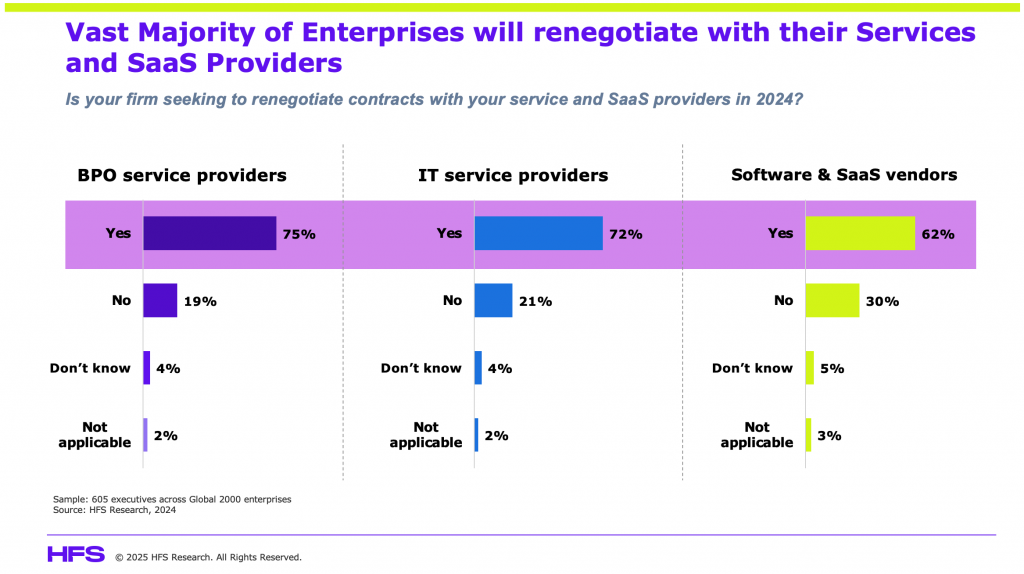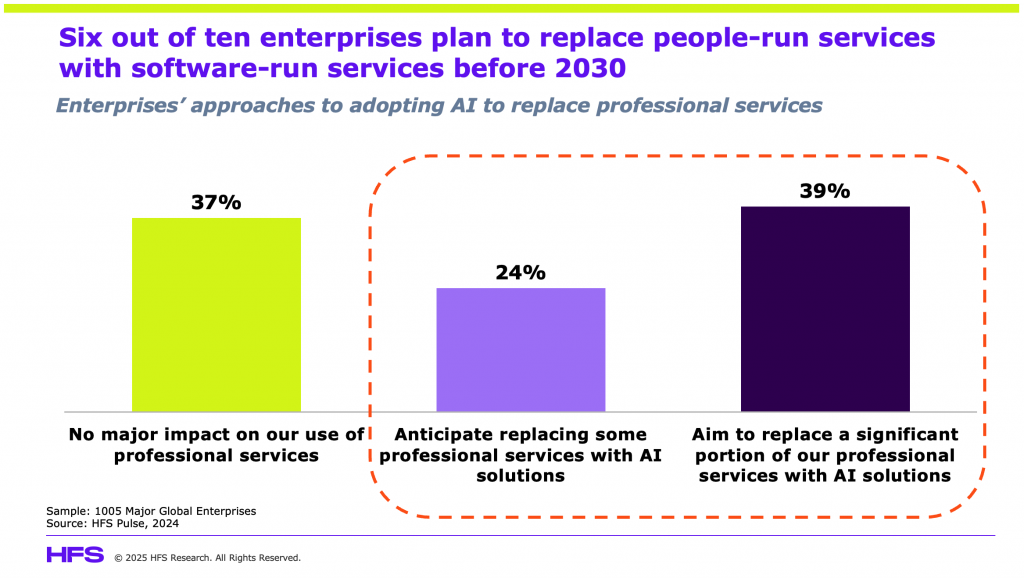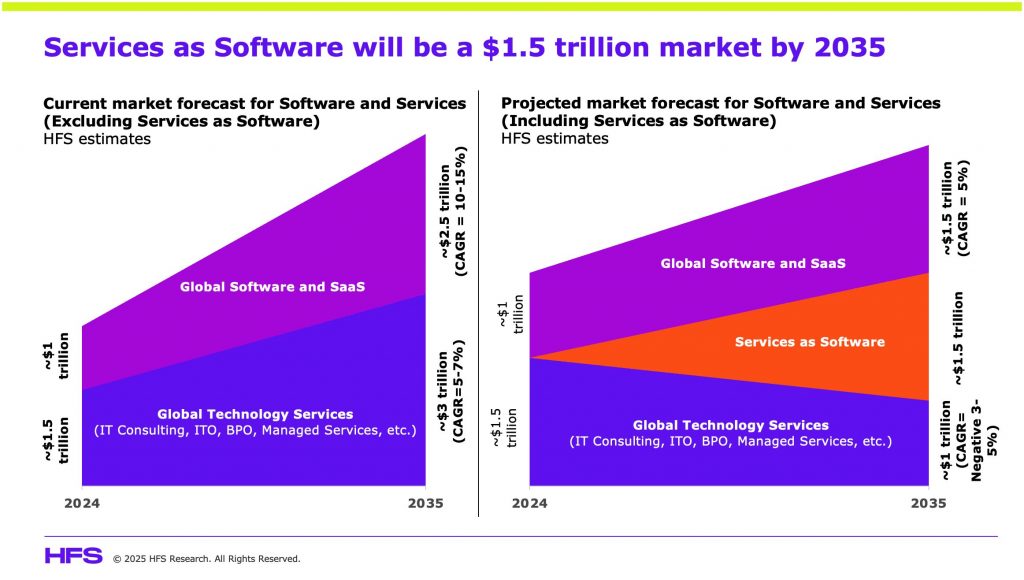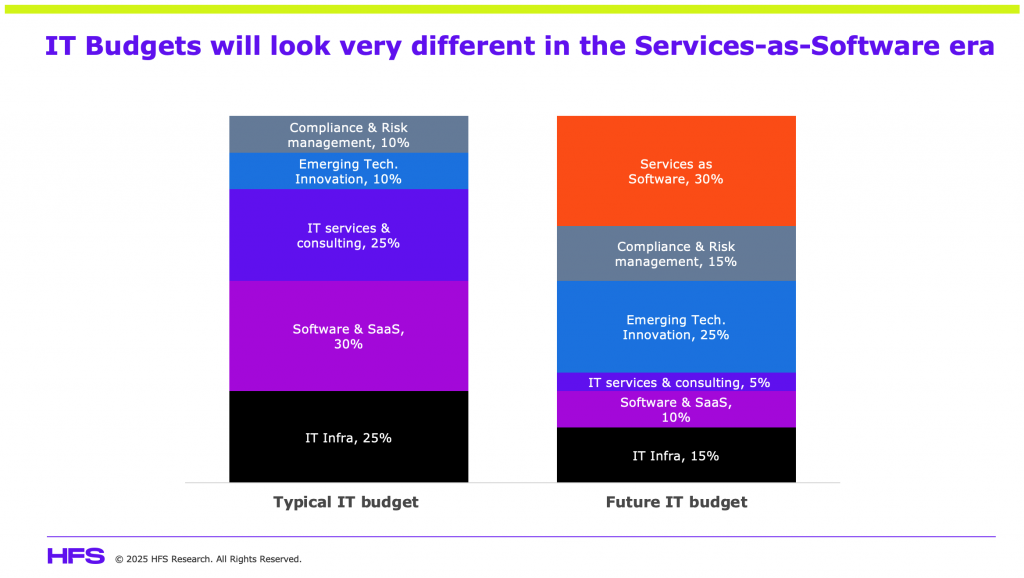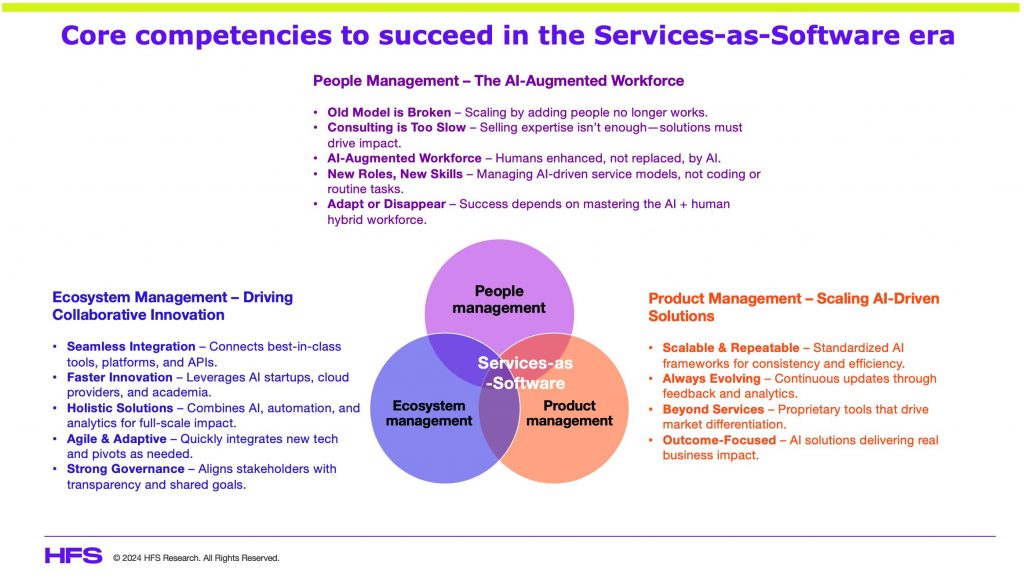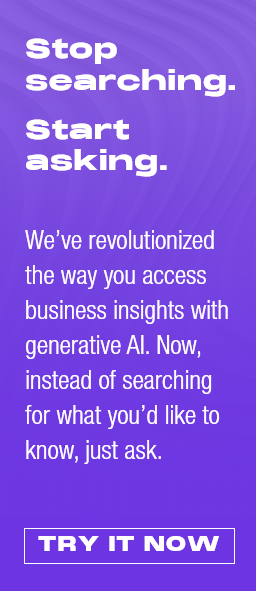Have you been taking your FOBO pills? Because without a healthy Fear Of Becoming Obsolete, you will likely end up in a dark place, desperately searching for someone to buy what you’re selling.
Cutting to the chase, if you think enterprise software and services will look anything like they do today in the future, you’re delusional.
- SaaS is a bloated, overpriced mess that forces companies to pay for features they don’t need.
- IT Services and Consulting are a glorified human labor business masquerading as innovation.
- CIOs are still spending billions on static tools and labor-heavy services when AI-first solutions can do far more for a lot less.
Talk to any C-Suite leader worth their salt, and they will tell you they are sick of spending more and more every single year on the same old software licenses and hiring more and more services people to make them work. This world cannot continue spending on low-value technology in perpetuity.
Why and how Services-as-Software will rewrite the enterprise tech playbook
Traditionally, software vendors have dominated the strategic sale of outcomes, while service providers have sold the tactical rollout of the software to reach these outcomes. The big challenge is for software firms to focus more on the tactical “how to” and services firms to be more relevant with the strategic “why.” This is an unprecedented time in technology history where outcomes, dreams, and tactical delivery are becoming one, and we don’t yet know who the clear winner will be.
Enter Services-as-Software—an AI-first, automated service layer that’s coming to obliterate everything in its path. No more billable hours. No more clunky SaaS.
That’s the HFS 2030 Vision—where we first coined the term Services-as-Software. A world where enterprises stop buying static technology and people-intensive services and instead consume AI-powered, outcome-driven solutions that continuously evolve and adapt to changing business requirements.
This isn’t a subtle shift. It’s a full-scale re-invention of enterprise technology as we know it. We’re already experiencing a secular change in how we buy, deploy, and consume technology, both in our professional and personal lives. The key is to stop clinging hold of the way we used to engage with tech and embrace the new before we become obsolete in the workplace. The old world of bloated spending on bad SaaS and bloated labor-based support deals is firmly in the past.
To reiterate this trend, HFS’s pulse survey of over 600 enterprise decision-makers reveals more than two-thirds of enterprises are frustrated with both their software and services investments and are primed to renegotiate their current contracts as they search for alternatives:
Software is broken—static, bloated, and dumb
Enterprise software promised efficiency but delivered clutter for decades. Packed with unnecessary features, it overwhelms users instead of empowering them. Pre-configured workflows assume businesses operate in predictable, linear ways, yet real-world challenges demand adaptability and agility. And despite the never-ending hype of automation, most software still relies on expensive consultants to stitch it together—turning “plug-and-play” into “pay-and-pray.”
Services are a scam—overpriced, slow, and labor-heavy
Consulting firms claim to sell expertise, but too often, they peddle generic templates disguised as bespoke solutions. The game is simple: create complexity, then charge clients to navigate it. Efficiency isn’t in their business model—hours billed are the real product. Organizations don’t pay for results; they pay for human effort, endless PowerPoints, and the illusion of transformation. In short, complexity has kept consultants and C-suite executives in jobs for decades as they tacked decade-long ERP rollouts, cloud migrations, and data transformation initiatives.
In a world that demands agility, both software and services are holding businesses back. It’s time for something better.
A brand new category of “Services-as-Software” is emerging
Services-as-Software eliminates this current BS—blending automation, AI-driven decision-making, and outcome-based pricing to finally deliver what enterprises need.
- Like services, it delivers expertise and decision-making.
- Like software, it is automated, scalable, and subscription-based.
- But unlike traditional SaaS and Services, it is adaptive, continuously learning from data to optimize processes in real time.
No wonder 6 out of 10 enterprises expect to replace at least some of their professional services with AI-driven solutions:
Forget configuring software. Forget hiring a bunch of consultants. Services-as-Software is the new model. It’s AI-first, service-led, and autonomous:
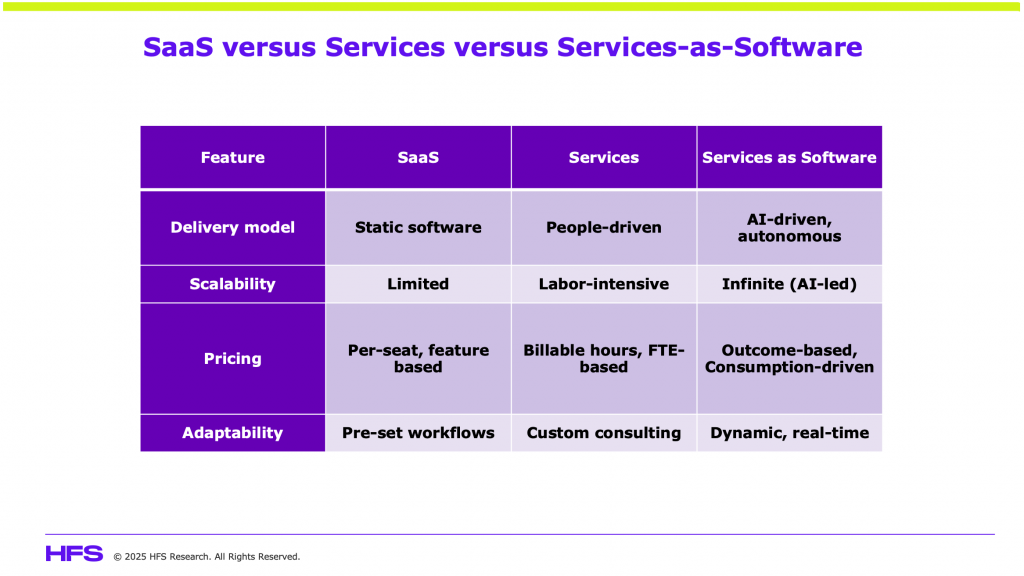
Services-as-Software will become a $1.5 trillion market by 2035, absorbing revenue from both traditional IT services and SaaS
By 2035, HFS projects Services-as-Software to grow into a $1.5 trillion market, absorbing revenue from both traditional IT services (which will shrink) and Software & SaaS (which will evolve and grow but at a slower rate):
These are our high-level projections based on several critical assumptions about enterprise technology adoption, AI progress, and industry transformation:
- Services-as-Software will erode traditional IT services revenue. IT services revenue (around $1.5T in 2024) will decline as AI-driven services replace traditional labor-intensive work in areas like IT outsourcing, BPO, and consulting. Many traditional services will become productized and subscription-based, leading to fewer billable hours and lower revenue from human-led services.
- SaaS growth will continue but at a much slower pace. SaaS growth (from around $1T in 2024 to $1.5T in 2035) will not just be from traditional SaaS licensing but from AI-powered, adaptive services. Software vendors will increasingly monetize AI-powered service layers instead of static software licenses.
- Services-as-Software will become a $1.5T category. New spending will not be incremental but will come at the expense of traditional services and software markets. Enterprises will stop hiring as many IT consultants and will move away from feature-based SaaS toward outcome-based AI solutions.
- AI innovation will drive down costs, increasing adoption. The cost of AI will continue to decline, making AI-driven services cheaper and more accessible for enterprises of all sizes. Open-source AI models will accelerate adoption of Services-as-Software by reducing development and implementation costs.
Agentic AI and “DeepSeek” inspired AI innovations will accelerate the shift to Services-as-Software
Agentic AI is emerging as the backbone of Services-as-Software. AI systems that autonomously take action make decisions, and continuously learn will drive the transformation of software and services into intelligent, self-operating solutions. Unlike traditional SaaS, which relies on pre-defined workflows and manual configurations, agentic AI learns, optimizes, and executes in real-time, eliminating the need for enterprise software licenses. Businesses will no longer need to buy and configure ERP, CRM, or other SaaS platforms; instead, AI agents will autonomously manage processes, analyze data, and take proactive actions (at least the easy ones) without human intervention.
The same shift will disrupt traditional service models like IT consulting, BPO, and professional services. Rather than hiring consultants to analyze data or outsourcing tasks to human workers, agentic AI will monitor operations, self-optimize workflows, and make business decisions in real-time—reducing dependency on billable hours and manual labor. The future of enterprise technology isn’t about AI-assisted work; it’s about AI-led execution. A future is emerging where businesses won’t need to buy software or hire service providers for everything—they will consume fully autonomous AI-driven solutions.
If you leave aside the geopolitics and the “AI cold war” between the US and China, DeepSeek’s recent AI advancements will also accelerate the movement toward Services-as-Software. DeepSeek’s underlying engineering innovations promise to make AI-powered solutions cheaper, more efficient, and widely accessible, accelerating the shift toward Services-as-Software. AI at lower costs enables cutting-edge capabilities at a fraction of traditional development expenses. Open-source AI is also democratizing access, allowing enterprises of all sizes to integrate powerful AI-driven solutions without prohibitive costs. Meanwhile, real-time expert reasoning is revolutionizing decision-making as AI increasingly replicates the expertise of human consultants, reducing the need for traditional advisory services. This shift levels the playing field, enabling even small businesses to harness AI-driven intelligence, accelerating adoption, and driving industry-wide disruption.
CIOs: It’s time to completely rethink your IT budget
A large enterprise typically allocates its technology budget across multiple categories, including IT infrastructure, software, services, innovation, and compliance. However, with the rise of Services-as-Software, this spending will shift from fixed investments in software licenses and human-driven services to AI-powered, outcome-based models (See Exhibit 4). AI-driven services will replace traditional workflows, dynamically adapting to business needs and optimizing processes in real-time:
Key Areas of IT Budget Growth:
- Services-as-Software becomes a major IT spend. Nearly a third of IT budgets will shift toward AI-powered service layers that replace static workflows with real-time intelligence. Spending on AI-as-a-Service will grow, covering automated advisory, compliance, and decision-making. Investments in AI-native process automation will replace traditional SaaS workflows, with outcome-based pricing models replacing per-seat software licensing.
- Increased investment in security, compliance, and governance. AI-enabled cybersecurity and automated compliance will become critical budget priorities. Regulatory technology (RegTech) spending will surge as businesses strengthen AI governance to meet evolving compliance requirements.
- Growing budget for emerging technology & innovation, Enterprises will increase spending on cutting-edge technologies beyond AI, including quantum computing, edge computing, blockchain, IoT, digital twins, and who knows what else! The focus will be on integrating these technologies into AI-powered platforms to drive competitive advantage.
Key Areas of IT Budget Decline:
- Shrinking IT services & outsourcing spend. AI-driven automation will significantly reduce reliance on traditional IT support, consulting, and application development. The demand for outsourcing contracts will decline as no-code/low-code AI solutions take over maintenance and customization.
- Declining enterprise SaaS spending. Businesses will move away from large, rigid SaaS contracts (e.g., Salesforce, SAP, Oracle) in favor of AI-driven, flexible, outcome-based platforms that continuously adapt to business needs.
- Infrastructure costs shift to AI-optimized cloud consumption. Traditional cloud spending will give way to AI-optimized compute environments, allowing enterprises to dynamically adjust workloads for greater efficiency and cost savings.
As AI and other emerging technologies reshape the enterprise landscape, IT budgets will prioritize intelligence over infrastructure, automation over manual processes, and outcomes over effort—accelerating the shift toward a fully AI-powered and innovation-driven operating model.
Who will win? The Providers who can master People, Products, and Ecosystems
Traditional IT services firms don’t know how to build scalable products. Traditional SaaS vendors don’t know how to deliver real-world services. Ecosystem building is not considered a core competency by either. The winners in the Services-as-Software era will be those who master all three core competencies:
- People Management,
- Product Management, and
- Ecosystem Management.
The Bottom line: Services-as-Software is not a death knell for service providers and software vendors. It’s the $1.5 trillion opportunity of our lifetime
As the lines between software and services blur, traditional tech providers can finally crack open the $1.5 trillion services market, while service firms can escape the FTE trap and regain hockey-stick growth. But the winners won’t be those who cling to outdated models—they’ll be the ones who fuse AI, automation, and expertise into scalable, outcome-based solutions.
This isn’t the end. It’s the biggest revenue shift in enterprise technology history. A brand new category is on the horizon. The big question is—who will seize it? That is yet to be seen…
Posted in : Agentic AI, Artificial Intelligence, Automation, Business Process Outsourcing (BPO), ChatGPT, Cloud, Consulting, Cybersecurity, GenAI, OneOffice, Services-as-Software, The Generative Enterprise


